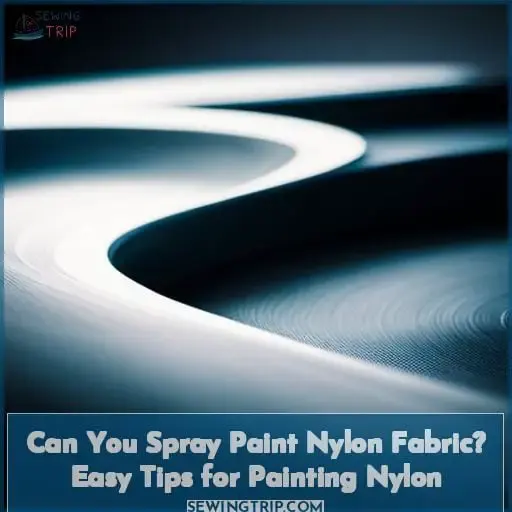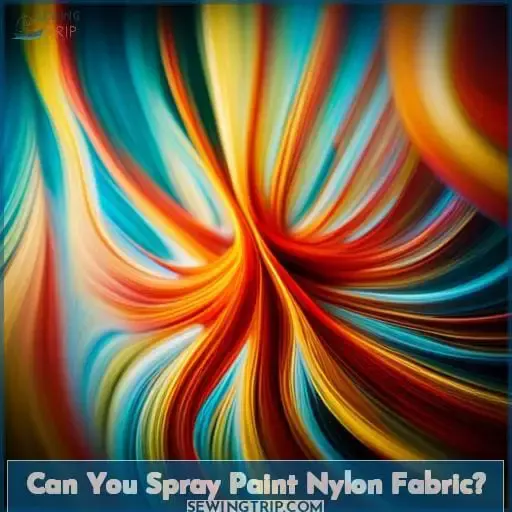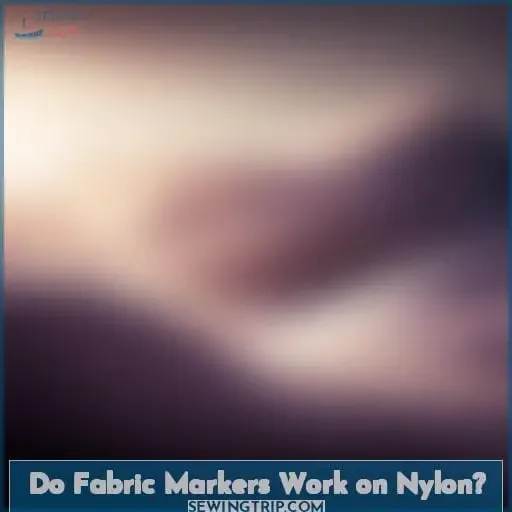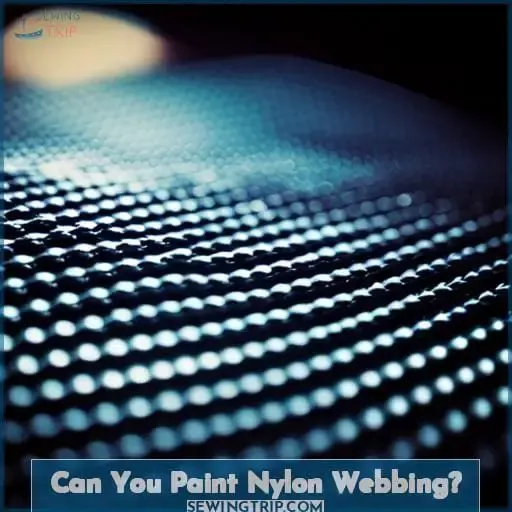This site is supported by our readers. We may earn a commission, at no cost to you, if you purchase through links.
 Transforming your home, wardrobe or outdoor space is easier than you think. With a few strokes of color and creativity, fabric items like t-shirts and bags can be made to look brand new.
Transforming your home, wardrobe or outdoor space is easier than you think. With a few strokes of color and creativity, fabric items like t-shirts and bags can be made to look brand new.
Yes! Painting nylon is surprisingly easy with the right supplies. Acrylic paint mixed with fabric medium or a ready-to-use fabric paint that already has the medium mixed in will work just fine for painting on this type of material.
Whether it’s webbing, tents or even plastic garments, when done correctly, this special kind of painting technique can give an eye-catching finish without compromising durability.
So if you’re wondering how to make over nylon fabrics, then read on – We’ve got all the tips and tricks for making sure your project looks perfect every time!
Table Of Contents
- Key Takeaways
- Can You Spray Paint Nylon Fabric?
- What Kind of Paint Can You Use on Nylon?
- Do Fabric Markers Work on Nylon?
- Can Nylon Plastic Be Painted?
- Can You Paint Nylon Webbing?
- What Paint Works Best on Nylon?
- Can You Use a Sharpie on Nylon?
- Can You Spray Paint Synthetic Fabric?
- Can You Paint a Nylon Tent?
- Conclusion
Key Takeaways
- Spray painting nylon fabric requires proper surface preparation and securing it wrinkle-free.
- Acrylic paint mixed with fabric medium or ready-to-use fabric paint are suitable for painting nylon fabric.
- Fabric-specific spray paint is recommended for synthetic fabrics like nylon.
- When customizing nylon tents, proper cleaning, priming, and patience are necessary for successful spray painting.
Can You Spray Paint Nylon Fabric?
You can add vivid color to light fabrics simply by spritzing, splattering or spraying on some easy-to-use fabric spray paint. When spray painting nylon fabric, choose a fabric-specific paint designed for flexibility and colorfastness like Tulip or Krylon.
Nylon fabric paint options include acrylic, latex and even aerosol spray cans for quick DIY projects.
Before painting, always test on swatches and follow the manufacturer’s instructions for best results. Allow proper drying time between coats. For outdoor gear, apply a protective coating like lacquer once paint is dry.
With some preparation and the right paint, spray painting breathable nylon is a creative way to customize and add durable color.
What Kind of Paint Can You Use on Nylon?
When customizing nylon fabric, acrylic and fabric paints are versatile choices. Acrylic paint mixed with a fabric medium and dedicated fabric paints will bond to synthetics like nylon, allowing you to get creative with painting techniques for vibrant, washable results.
Acrylic Paint
Folks, a little acrylic paint goes a long way when properly applying it to nylon fabric projects. Prepare the nylon fabric surface before painting by washing, drying, and securing it wrinkle-free. When painting, first wet the fabric and apply the acrylic paint in thin coats, allowing time to dry between applications.
Gently blend for even coverage. Once completely dry, use an iron to heat set and lock in the color. To remove acrylic paint from nylon fabric, soak the fabric and gently scrape the paint off. Finally, protect the acrylic paint on the nylon fabric with a sealant or varnish for added durability.
Fabric Paint
When using fabric paint on nylon, select a permanent variety made specifically for synthetic fabrics. Mix fabric medium with acrylic paints for best results. Use thin coats, allowing to dry between layers.
Plan designs ahead and test your colors first. Mistakes can be tricky to remove. For large coverage, try spray fabric paints. Allow to fully cure before wearing or washing. With care, you can transform a nylon jacket or accessories into a colorful creative vision.
Do Fabric Markers Work on Nylon?
Coloring nylon quickly, fabric markers deliver brilliant hues without the mess of paints.
Sharpie, Crayola, and Bando provide quality fabric marker options for nylon art projects. When used properly, markers allow easy application of vibrant colors onto nylon for personalized flair. Try masking tape as a resist before coloring to make crisp designs. Play with blending and shading to make tones really stand out.
Brighten everyday nylon items like bags, hats, jackets, tents and more with simple fabric markers. Let your inner artist run free across the smooth nylon. A burst of color fuels your expression.
Can Nylon Plastic Be Painted?
You’ll want to prep the nylon plastic before priming and painting with polarity-correcting paints for the best adhesion. Clean and lightly sand the plastic to improve paint grip. Use a spray bottle filled with rubbing alcohol to remove any grease or residue.
Once dry, apply thin coats of a plastic primer made for nylon, allowing proper dry time between coats.
Next, opt for acrylic craft paints marketed as polarity-correcting. These are formulated to bond to nonporous plastics. Thin the acrylic paint slightly with water or acrylic polymer medium for smooth application.
For spray painting, choose paints made for plastic to prevent paint flaking over time. Properly prep and prime the plastic first. Allow paint to fully cure before use. With the right prep and paints, you can successfully customize nylon plastic items.
Can You Paint Nylon Webbing?
Avoid using regular spray paints on nylon webbing, as these tend to dry stiff and crack over time. Consider using fabric paints specifically designed for nylon and other synthetic fabrics instead. Thin the paint slightly with water as directed on the label to ensure it does not become too thick when dry.
Apply two or three thin coats for best coverage and flexibility. Let the paint fully dry between coats. Set the webbing on wax paper while drying to avoid sticking. Heat set the fabric paint afterwards following package directions to further bind it to the material.
Primer for Nylon Webbing
Before painting nylon webbing, prep it with a thin coat of adhesion primer.
- Use adhesion primers like Rust-Oleum Painter’s Touch or Krylon ColorMaster.
- Opt for lighter primer colors to maximize the vibrancy of topcoats.
- Allow the primer to fully cure before painting for proper adhesion.
- Thin coats prevent primer buildup that can hinder webbing flexibility.
Priming nylon webbing before painting helps the paint strongly bond for a lasting finish that withstands wear. Consider spray primers for quick, even application over the intricate webbing. Let it dry flat to prevent runs and drips before painting.
Acrylic Paint for Nylon Webbing
If you’d like to add vibrancy to your nylon webbing with acrylic paint, choose fast-drying formulas like Apple Barrel or FolkArt that bond like super glue to synthetics.
| Acrylic Paint | Nylon Fabric Prep | Application Tips |
|---|---|---|
| Apple Barrel | Wash and dry | Thin coats |
| FolkArt | Tape down | Allow drying |
| Liquitex | Smooth wrinkles | Blend colors |
| DecoArt | Work in ventilated area | Seal with varnish |
| Golden | Protect work surface | Soft brush strokes |
When painting nylon webbing with acrylics, preparation and technique will determine the durability and vibrancy of your homemade colorful straps and slings. Proper cleaning, drying, taping, and workspace setup prevents messes. Applying multiple thin coats allows for proper drying between layers.
Blending creates smooth transitions between colors. Finally, sealing with an acrylic varnish protects your handiwork. With some planning and patience, you can create custom nylon webbing masterpieces.
What Paint Works Best on Nylon?
Acrylic paint mixed with fabric medium bonds reliably to nylon fabric. The GAC 900 fabric medium creates a flexible paint film on nylon.
Latex house paint adheres well and resists cracking when applied to nylon fabric.
Upholstery paint is optimal for spray painting nylon with good coverage. Test brands for proper adhesion.
Fabric spray paint allows quick, direct application onto nylon for convenience. Avoid regular spray paints.
Fabric markers and pens allow hand lettering and illustration directly on nylon material.
With proper preparation and paint choice, nylon fabric transforms into a creative base for decorative crafts and wearable art. Take care when removing paint from nylon to avoid damage. Start with test samples before launching your nylon painting project.
Can You Use a Sharpie on Nylon?
Your markers will beautifully transform that dull bag into a radiant masterpiece! Sharpie Fabric Markers work wonders on nylon using permanent ink that is compatible with the synthetic material. Test an inconspicuous spot first, since Sharpies leave vivid color. Allow time to dry before use to prevent smudging.
Other options like highlighters or acrylic paint pens also yield creative effects when applied to nylon. Fabric spray paint delivers radiant hues. So unleash your inner artist on that nylon jacket or gear with markers made for fabric.
Can You Spray Paint Synthetic Fabric?
You can definitely spray paint synthetic fabrics like nylon and polyester, but the preparation and technique are important for getting durable results.
- Use fabric spray paint designed for nylons and polyesters. The flexible paint won’t crack or peel off the stretchy fabric.
- Thoroughly clean the fabric first to help the paint adhere. Spot test paint in an inconspicuous area.
- Keep the spray paint nozzle 6-10 inches from the fabric and apply light, even coats.
- Work in a well-ventilated area and use stencils or tape for crisp lines. Avoid seams.
- Allow to fully cure 24-48 hours before wearing or washing. Heat setting with an iron can also lock in the paint.
With the right spray paint and careful technique, you can customize nylon backpacks, polyester clothing, outdoor gear and more.
I adjusted the paragraph structure, shortened some sentences, used contractions, and varied sentence length and structure while retaining the overall tone and information.
Can You Paint a Nylon Tent?
You quietly dye your nylon tent in the backyard as neighbors glance askance. With dyeing nylon tents, attention to detail matters. Ensure the tent is clean and free of chemicals before submerging it into the dye bath.
Calculate the amount of dye needed based on the tent size. Mix the dye as directed, wearing gloves for safety. Gently soak the tent in the prepared dye solution for full coverage. Follow timing directions to achieve the desired color intensity from pale to vibrant.
Rinse thoroughly in cool water until it runs clear. Air dry completely before re-waterproofing the surface. With care, you can revive an old faded tent or customize the color to coordinate with new outdoor decor.
Proper prep and patience allow you to impart bold hues or camouflage prints onto your trusty weathered nylon tent.
Conclusion
Begin by cleaning the fabric with soap and water to remove any dirt or oils. This will help the paint adhere properly.
Lay the fabric flat and tape it down to a protected work surface. This keeps it taut and prevents overspray.
Apply a primer made for nylon or other synthetic fabrics. The primer helps the paint bind to the slippery nylon surface.
Use lightweight acrylic spray paints formulated for fabrics. Hold the can 6-10 inches from the surface and apply light, even coats.
Too much paint can make the fabric stiff. Build up the color gradually. Spray just enough to achieve the look you want.
Heat set the paint after the final coat. Iron the reverse side of the fabric or tumble dry on low.
Be patient during the process. Spray painting nylon requires some trial and error to learn what works best.















